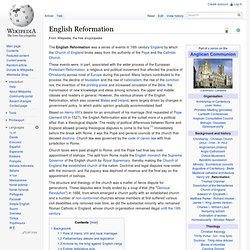

Counter-Reformation (religious history. Alternate titles: Catholic Reformation; Catholic Revival Counter-Reformation, also called Catholic Reformation, or Catholic Revival, in the history of Christianity, the Roman Catholic efforts directed in the 16th and early 17th centuries both against the Protestant Reformation and toward internal renewal; the Counter-Reformation took place during roughly the same period as the Protestant Reformation, actually (according to some sources) beginning shortly before Martin Luther’s act of nailing the Ninety-Five Theses to the church door (1517).

Early calls for reform grew out of criticism of the worldly attitudes and policies of the Renaissance popes and many of the clergy. Counter Reformation. The Reformation Online - The Most Timely, Scientific, and Patriotic Site on the Internet. English Reformation. The English Reformation was a series of events in 16th century England by which the Church of England broke away from the authority of the Pope and the Catholic Church.

These events were, in part, associated with the wider process of the European Protestant Reformation, a religious and political movement that affected the practice of Christianity across most of Europe during this period. Many factors contributed to the process: the decline of feudalism and the rise of nationalism, the rise of the common law, the invention of the printing press and increased circulation of the Bible, the transmission of new knowledge and ideas among scholars, the upper and middle classes and readers in general.
However, the various phases of the English Reformation, which also covered Wales and Ireland, were largely driven by changes in government policy, to which public opinion gradually accommodated itself. Church taxes were paid straight to Rome, and the Pope had final say over appointment of bishops. Protestant Reformation. Although the core motivation behind these changes was theological, many other factors played a part, including the rise of nationalism, the Western Schism which eroded people's faith in the Papacy, the corruption of the Curia, and the new learning of the Renaissance which questioned much traditional thought.

On a technological level the invention of the printing press proved extremely significant in that it provided the means for the rapid dissemination of new ideas. The Roman Catholic Church responded with a Counter-Reformation initiated by the Council of Trent and spearheaded by the new order of the Society of Jesus (Jesuits) specifically organized to counter the Protestant movement. In general, Northern Europe, with the exception of most of Ireland, turned Protestant. Southern Europe remained Roman Catholic, while Central Europe was a site of fierce conflict, escalating to full-scale war. Religious situation in Europe[edit]